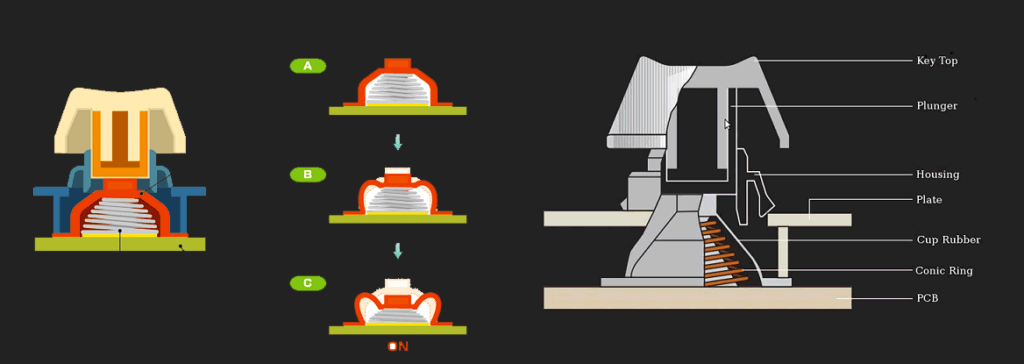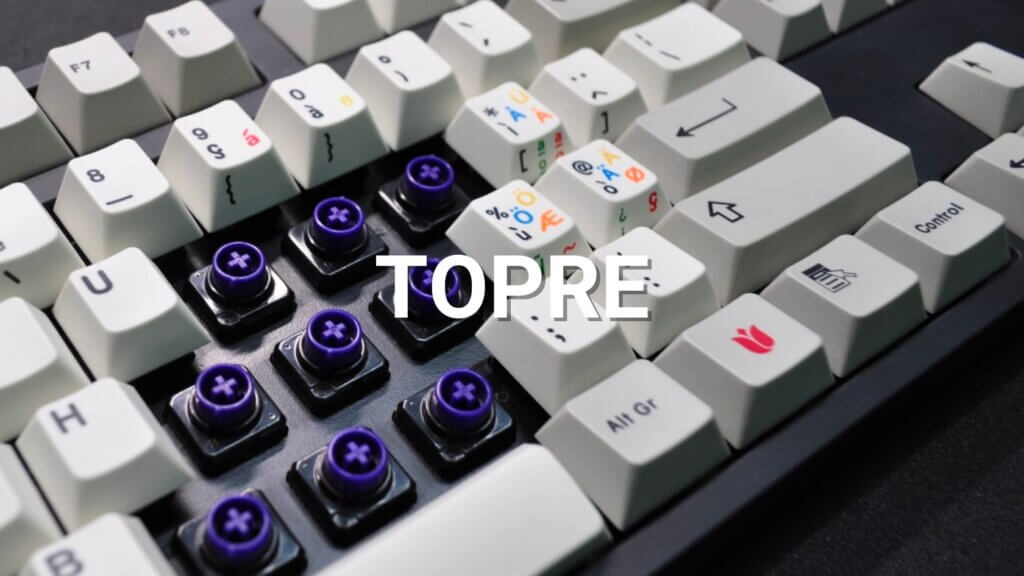In the world of keyboard switches, there’s one name that stands out for its unique blend of technology and tactile experience – the Topre switch.
This Japanese innovation has been a game-changer in the world of typing, offering a feel that’s often described as typing on clouds.
But what makes Topre switches so special? Are they worth the premium price tag? And how do they stack up against the popular Cherry MX switches?
In this comprehensive guide, we’ll delve into the fascinating world of Topre switches, exploring their history, functionality, and why they’ve become a cult favorite among keyboard enthusiasts.
Whether you’re a seasoned typist or a curious newbie, this article will give you a deep understanding of what makes Topre switches a truly unique phenomenon in the keyboard switch landscape.

What Is Topre Switch?
Topre switches are a unique blend of electrostatic, capacitive keyboard switches that offer the tactile sensation of a rubber dome keyboard, but with the added advantages of a mechanical switch.
These include enhanced tactility, reduced noise, and a non-squishy bottom-out.
However, their availability is limited to a select few keyboards.

When you press a Topre switch, the plunger is the first component to move downwards. This action compresses the rubber dome, which houses a spring.
A key press is registered when the electrical capacitance between the spring and the PCB (printed circuit board) hits a certain threshold.
Each rubber dome and conical spring is separate and can be easily replaced if damaged.
Topre Vs. Cherry MX Switches
Topre switches resemble Cherry MX browns, but with an added “thonk” and a sharper tactile feedback.
Comparing Topre and Cherry switches can be difficult due to the extensive selection of Cherry switches available. However, when it comes down to it, the choice ultimately depends on personal preference.
Topre switches boast a lifespan of approximately 50 million keystrokes, whereas Cherry MX switches double that with a lifespan of 100 million.
Topre switches, exclusive to certain keyboards, possess a unique feel. They have their fair share of admirers and critics, with some questioning their premium price tag.

What does it feel like to use Topre switches?
Let’s delve into their unique feel and why they stand out from other switch types.
Topre switches offer a comfortable and responsive typing experience.
They were primarily designed for typing.
Unlike the mushy feel of a membrane keyboard, Topre keyboards feature an adjustable rubber dome that alters the tactile feedback. This design prevents Topre switches from feeling squishy when bottoming out or pressing the key to its lowest point.
Many believe that due to Topre’s unique design, these switches should be tested before purchasing, especially considering their high price. However, they also retain their value well in the resale market.
Is Topre A Superior Brown Tactile Switch?
If you’re familiar with Cherry Browns, Topre switches are normally described as similar, but with a superior sound that’s less rattly or noisy and a sharp tactile feedback.
Typing on it is a smooth experience.
Some describe it as “typing on clouds.”
They come in different force options, ranging from 35g to 55g. These are average forces as there’s no specific actuation force or point.
Opinions on Topre switches vary widely. Some dismiss them as overpriced rubber dome keyboards, while others hail them as the smoothest switches to type on.
Topre Switch Sound Test
For a taste of what they sound like, here is the sound record of Topre switches on the premium keyboard HHKB for you.
If you’re considering a Topre keyboard, it’s likely for the sound. It produces a low-pitched bumpy sound that’s easy on the ears while typing.
You won’t hear the springy or clangy sound common in Cherry MX switches. It’s a soothing and soft sound.
Can I Get a Topre Switch for Testing?
Unfortunately, you can’t test Topre switches individually like MX style switches such as Kailh or Cherry. This is because you need a special PCB, case, spring, rubber dome, etc.
To acquire Topre switches, you must disassemble a pre-assembled mechanical keyboard that has Topre switches.
A significant advantage of Topre switches is the ability to replace individual rubber domes if one starts feeling mushy or different from the others.
You can also opt for higher or lower-force rubber domes. The “actuation” force ranges from 35g to 55g of average force.
The History of Topre Switches
| Time | Event |
|---|---|
| 1983 | TOPRE Corporation ventures into the production of mechanical keyboard switches. |
| 1986 | The first patent for Topre switches is filed. |
| 1986-Present | Topre switches are introduced as electrostatic capacitive non-contact keyboard switches. |
| 1986-Present | The unique design of Topre switches allows each rubber dome and conical spring to be a separate part, making them easily replaceable. |
| 1986-Present | Despite their higher price point, Topre switches gain popularity in the market, with many keyboards featuring these switches retailing for over $200. |
Topre switches are the brainchild of the TOPRE Corporation. This Japanese manufacturer is the sole producer of Topre switches. The company ventured into the mechanical keyboard switches domain in 1983, and the first Topre switches patent was filed in 1986.
In Conclusion
Topre switches are a unique breed of keyboard switches with a distinct feel and sound.
Despite their higher price tag, they offer an incredibly satisfying user experience, and we encourage everyone to give them a try. We believe they outperform Cherry MX Brown switches, but they are also pricier and don’t last as long, so there’s a trade-off to consider.
